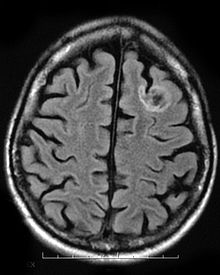Neuroepithelial cell
Neuroepithelial cells, or neuroectodermal cells, form the wall of the closed
Neuroepithelial cells are the stem cells of the central nervous system, known as neural stem cells, and generate the intermediate progenitor cells known as radial glial cells, that differentiate into neurons and glia in the process of neurogenesis.[1]
Embryonic neural development
Brain development

During the third week of
Neuroepithelial cell proliferation

Neuroepithelial cells are a class of stem cell and have the ability to self-renew. During the formation of the neural tube, neuroepithelial cells undergo symmetric proliferative divisions that give rise to two new neuroepithelial cells. At a later stage of brain development, neuroepithelial cells begin to self renew and give rise to non-stem cell progenitors, such as
Radial glial cell transition
Neuroepithelial cells give rise to radial glial progenitor cells in early embryonic development. To make this change, neuroepithelial cells begin to downregulate their epithelial features, by stopping the expression of
Adult neurogenesis
Genesis of neuroepithelial cells in the adult CNS
Neurogenesis in neural repair
Neurogenesis in the adult brain is often associated with diseases that deteriorate the CNS, like
Associated diseases
Dysembryoplastic neuroepithelial tumor (DNT)

A
Neuroepithelial cysts
Neuroepithelial cysts, also known as colloid cysts, develop in individuals between the ages of 20 and 50 and is relatively rare in individuals under the age of twenty. The cysts are benign tumors that usually appear in the anterior third ventricle. The cysts occur in the epithelium putting their patients at risk for obstructive hydrocephalus, increased intracranial pressure, and rarely intracystic hemorrhage. This results from the cysts enlarging by causing the epithelium to secrete additional mucinous fluid. The cysts are usually found incidentally or if patients become symptomatic presenting with the symptoms of hydrocephalus. The larger cysts are operated on while smaller cysts that are not obstructive can be left alone.[10]
Oligodendroglial tumors
Ongoing research
Neural chimeras
Researchers have been able to create neural
Depression
Research on depression indicates that one of the major causal factors of depression, stress, also influences neurogenesis. This connection led researches to postulate that depression could be the result of changes in levels of neurogenesis in the adult brain, specifically in the dentate gyrus. Studies indicate that stress affects neurogenesis by increasing Glucocorticoids and decreasing neurotransmitters such as serotonin. These effects were further verified by inducing stress in lab animals, which resulted in decreased levels of neurogenesis. Additionally, modern therapies that treat depression also promote neurogenesis. Ongoing research is looking to further verify this connection and define the mechanism by which it occurs. This could potentially lead to a better understanding of the development of depression as well as future methods of treatment.[13]
See also
References
- ^ ISBN 9780781790697.
- ^ ISBN 978-1-932594-10-2. Retrieved 7 December 2011.
- ^ ISBN 978-0470016176.
- ^ S2CID 16955231.
- PMID 12931233.
- S2CID 14149058.
- ^ PMID 18566676.
- S2CID 6610255. Retrieved 2011-11-28.
- ^ "Dysembryoplastic Neuroepithelial Tumor". Children's Hospital Boston. Archived from the original on 26 September 2011. Retrieved 1 November 2011.
- ^ Chin, L. S.; Jayarao, M. "Colloid Cysts". Medscape. Retrieved 7 December 2011.
- ^ "Oligodendroglioma". Macmillan. Retrieved 7 December 2011.
- S2CID 14847541.
- S2CID 24913141.
External links
- neuroepithelial+cells at the U.S. National Library of Medicine Medical Subject Headings (MeSH)
